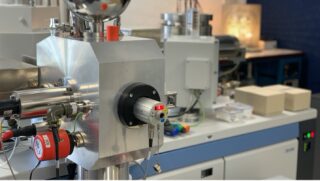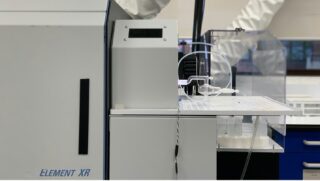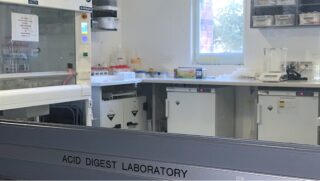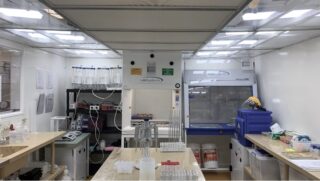Thermal Ionization Mass Spectrometry Facility
The Thermal Ionisation Mass Spectrometry (TIMS) Facility provides highly accurate and precise measurements of the isotopic composition of elements using a Thermo Scientific Triton™ TIMS instrument. The TIMS Facility includes two clean laboratories for sample preparation in clean, contamination-free environments. The history of TIMS-based research at Curtin can be traced back to the 1960s, when the isotope study group carried out atomic weight measurements, extraterrestrial and Rb-Sr chronological studies. The TIMS Facility at Curtin University has contributed to accurately measuring the concentrations of various elements in international reference materials. The currently accepted atomic weights of Cd, Te and Sn are based on measurements made at Curtin.
We specialise in the generation of high-precision geochronology and isotope data for application to a wide range of isotope geochemistry and geochronology, geological and environmental research applications.
Techniques/Capabilities
The TIMS Facility specialises in the implementation of the isotope dilution method. Pairing the TIMS instrumentation with the isotope dilution methodology can determine elemental concentrations to an ultra-trace level (i.e. sub pg g-1). This technique is considered the ‘definitive’ method of analysis for producing the highest achievable accuracy and precision of isotopic ratio information being widely used for the calibration of isotopic standards, the calculation of isotopic abundances and atomic weights. Although the Curtin TIMS and clean facilities can be applied to isotopic analysis of most heavy elements on the periodic table, the current focus is on:
- Re-Os isotope determination: for model ages of molybdenite, isochron geochronology of sulphides, hydrocarbons, or black shales, for igneous source tracer studies, and isotope fingerprinting for the minerals and energy sector. Double Os spike in conjunction with Carius tube technique is used for molybdenite analysis. Re-Os isotope studies can be complemented by low-level Platinum Group Elements determination using isotope dilution technique.
- Pb-Pb isotope determination: model ages of galena/sulphides, K-feldspar and native gold, isochron geochronology of whole rock and mineral separates, and for source tracer studies. The Pb isotopes are measured using double Pb spike on TIMS with precision 0.01%. Note that source tracer studies are often integrated with SHRIMP U-Pb age and Laser-ICPMS geochemical fingerprints, also analysed at Curtin.
Infrastructure – Instrumentation

Thermo Scientific Triton™ TIMS
Our ThermoFisher Triton™ TIMS instrument features a multi-collector system consisting of nine 1011 Ohm resistance Faraday cups. In addition to the Faraday collectors, our instruments ion counting systems include: a secondary electron multiplier (SEM), Retarding Potential Quadrupole Lenses (RPQ) for improved abundance sensitivity, and an additional multiple ion counting setup. The TIMS represents the gold standard for isotopic analysis, reaching a precision of 0.001% on isotopic ratios.
The Triton™ TIMS instrument is housed in a newly remodelled, High Efficiency Particulate Air (HEPA) filtered, positively pressured laboratory thereby minimising the interference of ultra-trace samples from contaminated outside air. Within the TIMS laboratory, there is a vacuum outgassing unit and a non-exhaust horizontal laminar flow hood for loading samples. For welding filaments, the laboratory has two dedicated benchtops in separate locations and welding stations to keep the Os material (Pt filaments) set apart from the other isotope system analytical material (e.g. Re and Ni filaments).

Thermo Scientific ELEMENT™ XR: Extended Dynamic Range High Resolution ICP-MS
The Facility also incorporates an ELEMENT™ XR high-resolution inductively coupled plasma mass spectrometer (HR-ICP-MS) instrument which provides quantitative multi-element analysis of trace and ultra-trace elements over a wide linear dynamic range, from the ppm to the sub-ppb level of elements ranging from Li to U in a very short amount of time. The Thermo Scientific ELEMENT™ XR HR-ICP-MS includes the combination of a single Faraday collector with the dual mode (counting and analogue) SEM, increasing the linear dynamic range to over 1012 orders of magnitude allowing for the simultaneous measurement of elements at concentrations from < fg/g to > 1000 μg/g in a single analysis. The instrument has a range of sample introduction components available, allowing for a variety of samples to be analysed: such as an ESI SC4 DX autosampler system that allows for measurement of up to 240 samples without changing configuration.
This instrument is co-located within the Western Australia Thermochronology Hub Facility. The ELEMENT™ XR is also routinely used to measure all Re for Re-Os projects as well as Highly Siderophile Elements (HSEs: Ir, Ru, Pt and Pd) for minerals and energy sector projects and trace element suites of digested mafic silicate material, sulphides and hydrocarbons.

Infrastructure – Clean Laboratories
Acid Digest Laboratory
Sample preparation and chemical separation of elements is carried out in a purpose-build Acid Digest Laboratory with clean air environment designed for low-blank processing of geological samples for isotopic measurements. The Acid Digest Laboratory is a positively pressurized clean room equipped with ULPA-Filtered air to reduce particle levels, an ANALAB hotplate with no exposed metal, a ducted ULPA-filtered fume cupboard (class 10/ISO 4 vertical laminar flow workspace) and deionized distilled ultra-pure water.

Trace Research Advanced Clean Environment Facility (TRACE)
For ultra-trace sample material, the TRACE Facility is a 434 m2, pressurised, class 100 (ISO 5) clean air space housing five class 10 (ISO 4) ultra-trace laboratory modules, of which the TIMS Facility clean laboratory is located in Module 2. The extremely low ultimate particle counts are achieved with successive ‘spaces within spaces’ and HEPA filtration at each stage.
The class 10 (ISO 4) Module 2 laboratory within the TRACE Facility contains a ducted ULPA-filtered fume cupboard (class 10/ISO 4 vertical laminar flow workspace) equipped with a scrubber for hydrofluoric acid use, an ANALAB hotplate with no exposed metal, and a laminar flow workbench within the centre of the module for an extremely low particle count workbench for the handling of sample solutions and chromatography.
Most acids used within both the Acid Digest Laboratory and the TRACE Module 2 Laboratory are distilled in-house within the TRACE Module 2 Laboratory via two sets of Savillex DST-1000 acid purification systems (a dedicated set each to double distil HCl and HNO3) and sub-boiling Teflon elbow stills (CCl4). The HBr and H2SO4 acids are purchased already purified (Seastar range).
Applications
The present applications utilised within the TIMS Facility are mainly in the broad field of geochronology and isotopic tracing studies involving Re-Os and Pb-Pb isotope systems as well as in isotope fingerprinting (Os-Pb isotope systems and Highly Siderophile Elements determined via isotope dilution) in the study of ore- and petroleum formation processes.
Exploration for Potential of Economic Deposits
- Fundamental and applied studies to better understand the genesis, evolution, geodynamic setting with a goal to better predict the location of mineral deposits for exploration.
- Using isotope geochemistry integrated with U-Pb geochronology to discern the sources and age of volcanic and plutonic rocks from ‘brownfield’ mineralised regions and underexplored Western Australian ‘greenfields’ regions specifically targeting mineral exploration.
- Nationally coordinated regional-scale isotopic mapping of igneous rocks to better understand the crustal structure and to help identifying fertile, primitive geological terranes most likely to host giant ore deposits.
Understanding Mantle and Crustal Processes
- Fundamental isotope geochemistry studies into the creation of the crust and the evolution of the mantle through local terrane specific research to national scale mapping projects.
- Isotopic tracing of the sources of volcanic rocks and using multiple geochronological techniques to constrain the petrogenesis and evolution of these igneous systems (which often produce or are involved in the genesis of mineralising systems).
Direct Dating and Fingerprinting of Petroleum Systems
- Applying the Re-Os mass spectrometry technique to fingerprint oil, pyrobitumen and shales and determine provenance, timing of hydrocarbon expulsion and depositional age of source rocks.
Research Highlights
Isotope mapping
An Isotopic Atlas of Australia has been progressively compiled by Geoscience Australia over many years as an aid to future mineral discovery. What began primarily as a national scale isotopic mapping of Sm-Nd isotopic analyses to determine rock source heritage, has now extended to U-Pb age and Lu-Hf (mostly zircons), Pb-Pb (galenas and other Pb-rich minerals) and K-Ar/Ar-Ar (K-rich minerals) isotopic systems. During the first iteration of the Pb-Pb isotopic mapping from 2017 – 2021, mineralised areas were targeted (Huston et al., 2019; Huston et al., 2023). In a new project in collaboration with Geoscience Australia we pursued the opportunity to greatly enhance the potential of Pb-Pb isotopic mapping by expanding the coverage of Pb-Pb isotopic information to all rocks which have been isotopically dated. The outcome of the current GA-sponsored research is that whole rock Pb-Pb isotope analyses provide the most reliable compliment to the sulphide-based Pb isotope mapping of Australia.
The technique therefore is applicable to >4,500 rocks within the Geoscience Australia collection, which have already been dated precisely, and can then be applied to all such future rocks collected and dated precisely. Lastly, in addition to providing a better understanding of potential mineralised system locations and thus reducing exploration risks, by combining Pb isotopes with the Sm-Nd (or Lu-Hf) isotopic signatures already determined from the same dated rocks, allows assessment of the degree of isotopic communication from deep level fractionation systems to those higher in the crustal column.
Publications:
- Huston, D.L., Champion, D.C., Czarnota, K. et al. Zinc on the edge—isotopic and geophysical evidence that cratonic edges control world-class shale-hosted zinc-lead deposits. Miner Deposita 58, 707–729 (2023)
- Huston, D. L. et al. Preliminary national-scale lead isotope maps of Australia. Record 2019/001. Geosci. Aust. Canberra, Rec. (2019)
Gold fingerprinting
Native gold has proven to be difficult to characterize geochemically due to its scarcity, small sample size, mono-isotopic nature, and due to the specific protocols and dedicated equipment required to overcome analytical difficulties. Therefore, direct geochemical studies of native gold are sparse and the majority of information about the age and origin of gold deposits comes from associated bedrock and accessory minerals. To address this issue, we investigated 24 small gold nuggets from various locations in Western Australia, including the Pilbara Craton (Silica Hills, Mallina, Marble Bar and Mosquito Creek prospects), Yilgarn Craton (Kurnalpi Terrane), and Capricorn Orogen (Paulsens and Mount Olympus deposits), with the aim of constraining the age and source of gold mineralization directly from gold. The samples were analysed for Pb and Os isotopes, PGEs, and other trace elements using wet chemistry techniques in combination with thermal ionization mass spectrometry (TIMS) and high-resolution inductively coupled plasma mass spectrometry (HR-ICP-MS). We assessed the applicability of these analytical techniques for isotopic and sub-ppm to sub-ppb trace element fingerprinting of native gold samples and gold reference standards. A major report on these outcomes was published in GSWA Records.
Publication:
Development of Molybdenite Reference Materials for In Situ LA-ICP-MS/MS Re-Os Geochronology
Re-Os isotope-dilution geochronology has been widely used to date the timing of molybdenite, pyrite and chalcopyrite formation across a variety of geological settings. However, in situ methods have been impeded by the isobaric interference of 187Re on 187Os. In situ Re-Os geochronology using LA-ICP-MS/MS has been shown to be a useful technique to chemically separate Os from Re, as Os reacts with CH4 to create higher-mass reaction products, which can then be measured with minimised interference of 187Re. However, application of the method requires matrix-matched primary reference materials, e.g., age-homogenous molybdenite amenable to laser ablation. Here, we characterise and present two new molybdenite mineral reference materials for in situ Re-Os geochronology by LA-ICP-MS/MS, verified by ID-TIMS Re-Os measurements. We also present case studies from molybdenite samples with varying Re mass fractions and Re-Os age mapping. The method provides accurate and precise age data, with excellent precision for high Re samples. The benefits of the LA-ICP-MS/MS approach include: (1) simple sample preparation, (2) rapid data acquisition, (3) targeting of specific textural domains including growth zones and (4) the ability to simultaneously collect trace elements used to link the timing and conditions of ore-formation.
Publication:
Sediment-hosted copper deposit in Queensland
Most metal ore deposits in Queensland are hydrothermal in origin, and most form sulphides as ore, and ore-associated minerals. The ability to use the Re-Os and Pb-Pb isotopic systematics to determine the age and origin of sulphides has been known for many years, but the technical advances for routine analysis and the establishment of the required analytical infrastructure has been achieved in the John de Laeter Centre at Curtin University. Previous geochronology studies of ore deposits in Queensland have relied on dating ore-associated and alteration minerals. This proposal seeks to utilize the Re-Os isochron method and Pb-Pb isotopes on sulphides to determine precise ages and origin of metals in Capricorn Cu deposit in Queensland. This deposit contains ore-related pyrite, which apart from rare molybdenite, is the most reliable common sulphide for Re-Os geochronology. Re-Os isochron ages could be complemented (if appropriate) by precise U-Pb and Ar-Ar ages on the selected deposits and their environs, including hostrock, stratigraphic ages, alteration and metamorphic ages, to build a precise 4D framework of ore formation.
